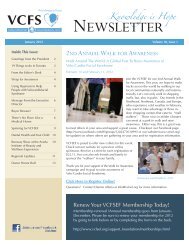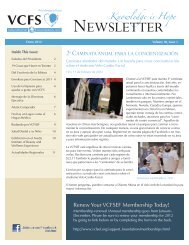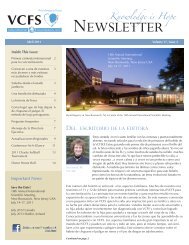English Newsletter - Velo-Cardio-Facial Syndrome Educational ...
English Newsletter - Velo-Cardio-Facial Syndrome Educational ...
English Newsletter - Velo-Cardio-Facial Syndrome Educational ...
You also want an ePaper? Increase the reach of your titles
YUMPU automatically turns print PDFs into web optimized ePapers that Google loves.
P AGE 6VCFSEF NEWSYour regional directorsAhmad Al-KhattatUnited KingdomAhmad Al-Khattat is a Podiatrist workingin the UK. He has been studyingthe phenomenon of leg pain in VCFSsince 1995. He has attended all theFoundation's meetings since 1996 andtook part in organising the 2002 meetingin Northampton UK. He waselected a member of the Board of directorsof the VFFS <strong>Educational</strong> Foundationin 1998 for a 3 years term. He wassubsequently elected as a chairman forits nominating committee." Last year hewas elected VCFSEF Co-Regional Directorfor the United Kingdom (with JulieSquair).There are a number of active VCFS supportgroups and research centers in theUK and in Europe. Together with theEuropean Foundation's office headedby Dr Stephan Eliez, the UK office ishoping to take part in bringing thesedifferent activities together to in an attemptto amalgamate the efforts of suchvarious organisations that are workingfor the same aims and objectives. TheVCFS <strong>Educational</strong> Foundation remainsthe central processing unit for all theseefforts, which will hopefully attract othersto join in.Julie SquairUnited KingdomI was thrilled to be elected as RegionalCo-Director for the UK and Ireland andlook forward to helping fulfil the aimsand objectives of the VCFS <strong>Educational</strong>Foundation from this side of the world.In the UK we are lucky to have severalgroups who are working hard to givesupport to families on a daily basis. Ihope to be in regular contact with allthese groups in the not too distantfuture in order to form a link betweenthem and the <strong>Educational</strong> Foundation.On a personal note, I am the parent ofa VCFS child and one of the foundingmembers of The 22q11 Group in theUK. I was privileged enough to be ableto attend the first VCFSEF conferencein New York in 1995 when Hazel wasalmost five years old, and find it hardto believe that she is almost 16 yearsold and leaving compulsory educationin summer 2005 how time flies!Originally qualified as a bilingual secretary(almost 25 years ago now!), I nowteach Spanish to adults. I also spentthe last school term teaching 14/15year olds – many of them with learningdifficulties. That was an experience!Stephan Eliez, MDEuropeI am a child psychiatrist, with trainingin medical genetics. Early in my professionaltraining, I developed a stronginterest in VCFS. I thought a betterunderstanding of how children andadolescents with VCFS develop wouldhelp us take care of potential problemsearlier and treat individuals more efficiently.In 1997, I went to Stanford Universityin California for 4 years. There, webuilt an extensive research programcombining genetics, neuro-imagingand cognitive neurosciences in VCFS.During the same period, I worked withthe local Northern California VCFSSupport Group to increase knowledgeand awareness on VCFS in the community,and became an active member ofthe VCFS <strong>Educational</strong> Foundation.In October of 2001, I relocated to Switzerland(my native country) andstarted a research and a clinical programon VCFS in Geneva. I am a boardmember of the Swiss and French VCFSsupport groups (Connect22.ch andGénération 22). I strongly believe thatthere is a considerable benefit for nationaland international VCFS familyassociations or foundations to uniteand work together. Together, we willget more attention and resources toimprove the life of individuals withVCFS and their families.
V OLUME 10, ISSUE 1P AGE 7Your regional directorsDoron Gothelf, MDMiddle EastI am an adult, child and adolescent psychiatristworking at Schneider Children’s MedicalCenter of Israel.. I have been studyingVCFS for almost a decade, with a focus onits emotional, behavioral and psychiatriccharacteristics and their treatment. I havealways believed that children with developmentaldisabilities should be treated in asingle clinic situated within a children’shospital so that it could provide for all theirmedical and psychosocial needs and alsosupport family members.For these reasons, about 3 years ago, Iestablished the Behavioral NeurogeneticsClinic for the treatment and study of subjectswith VCFS and Williams syndrome.The clinic is so organized that all medicaltreatment is offered to individual child inone concentrated day. It also works closelywith the parents’ association and offers awide range of psychosocial programs andactivities, such as parental support groups,big brother programs, and social and sexualeducation groups. We aim to serve as a“second home” to children with VCFS andtheir families.The clinic is currently attended by about120 patients with VCFS from all over thecountry, both Jews and Arabs. As such, webelieve the clinic can also serve a widerrole, as part of a bridge to peace. This isespecially important in these days of growingtension in the Middle East. As a firststep, we translated the Foundation’s lastnewsletter into Arabic and Hebrew, fordistribution to our neighbors.This year, I am currently on sabbatical atStanford University, in the Department ofChild Psychiatry. Please do not hesitate tocontact me for any information on VCFS.Steve RussellAustralia/Pacific RimSteve Russell is the Foundation's RegionalDirector for Australia and thePacific Rim. Steve is President of theVCFS Foundation of Queensland, Australia,which he and wife Kathy(secretary of the Queensland Foundation)established in 1997. Steve is alsochairman of the Australian nationalVCFS Foundation, formed last year.Steve is married to Kathy, and has sixchildren. He lives with his family in Brisbane.Steve is a lawyer, and has hisown practice in Brisbane, specialising inCommercial Litigation and Corporateadvice.He lists his interests as reading, golf andrugby. He is a (lapsed) marathon runner.Antonio Ysunza, MD, ScDLatin AmericaGreetings from Latinoamérica to everyone in the <strong>Velo</strong>-<strong>Cardio</strong>-<strong>Facial</strong> <strong>Syndrome</strong><strong>Educational</strong> Foundation, Inc.My first contact with <strong>Velo</strong>Ccardio-<strong>Facial</strong> <strong>Syndrome</strong> was twenty years agowhen I was doing a post-graduatefellowship with my professor and nowgood friend Bob Shprintzen in NewYork City. At that time I was a physicianfinishing a residency in Audiology,Phoniatrics and Clinical Electrophysiology.During these twenty years, in myHospital at Mexico City, we have gonetrough a necessary learning curve concerningthe identification of cases. Atthis point in time, everyone in my centeris familiar with the <strong>Velo</strong>-<strong>Cardio</strong>-<strong>Facial</strong> <strong>Syndrome</strong>. However, we are stilllooking for better diagnosis and treatmentoptions for our patients. It will bemy pleasure to offer all the informationavailable to anyone in Latinoaméricawho is interested in <strong>Velo</strong>-<strong>Cardio</strong>-<strong>Facial</strong><strong>Syndrome</strong>. I will be delighted to provideall the information in Spanish ifnecessary. I have already translatedthe last Foundation newsletter intoSpanish.Please, feel free to contact me anytimeabout information regarding VCFS.
P AGE 8VCFSEF NEWSThe art of negotiating: Dealing withproblems efficientlyCoby J. Anderson, J.D. & Linda L. D’Antonio, Ph.D.Negotiating for the needs of your child can be time consuming andfrustrating. Many negotiations result in overt conflict, and conflict iscostly in terms of time, money, and emotion.There are a variety of ways you can deal with conflict:• You can avoid it to preserve the peace but this usually weakensthe relationship in the end and your needs are not met• You can compromise or accommodate, which preserves therelationship, but this can result in a lose-lose outcome when noone gets what they wanted,• You can compete but this usually results in a win-lose, or at besta tie, you may achieve your goal but weaken the relationship• Or, you can collaborate.Our premise is that collaboration, working together with the partiesinvolved is the most effective and in the end, the least costlymethod for dealing with conflict. It has the greatest potential forachieving your goal while building the relationship. In short, collaborationhas the best chance of achieving a win-win or all gainoutcome.Fisher and Ury (1981) have described a very effective method fordealing with conflict called Principled Negotiation. This was developedat the Harvard Negotiation Project and is described in thebook “Getting to Yes” which is readily available and easy to read.This method emphasizes deciding issues on their merits rather thanthrough a haggling process focused on what each side says it willor will not do. It suggests you look for mutual gain, not win-lose oreven win-win, but all gain. Principled negotiation allows you toreach a gradual consensus on a joint decision efficiently without allof the costs that can occur when people dig into positions. It is likelythat you may already be using some or all of the principles describedin this method. But, if you are like most of us, it is very helpfulto have these principles laid out in a structured manner so that itis easier to follow and use. Principled negotiation is an “all purpose”strategy. It is useful in all areas of your life, not just in negotiatingfor your child’s needs.There are 4 key elements to Principled Negotiation:• separate the people from the problem• focus on interests, not positions• invent options for mutual gain• insist on using objective criteriaSeparate the people from the problemEach person in a conflict has two kinds of interests, substance (thatis, the issues(s) you are in conflict over) and, the relationship. Unfortunately,the relationship tends to get entangled with the problemand we treat the people and the problem as one. So thefirst step in effective conflict resolution is to separate therelationship from substantive issues. Over the course ofyour child’s care you will have relationships with a varietyof people doctors, therapists, teachers, coaches etc. Thegoal of principled negotiation is to deal with the substantiveissues while maintaining or building these relationships.Focus on interests not positionsThe second element in effective negotiation is focus oninterests not positions. This principle underlies every formof mediation. In negotiating, ask “why” you want something.Why does the other person want what they saythey want? These are your interests.Your position is something you have decided upon. Yourinterests are what caused you to decide. Interests arewhat motivate people but they may not be easy to see onthe surface. In negotiating you want to focus on intereststo find issues that may be shared or compatible. But it isimportant to remember that agreement is often made possibleexactly because interests differ.Invent options for mutual gainInterests are why you need what you are asking for. Optionsare ways to get what you need. The best outcomeoccurs when the interests of both parties are met. Howevermost often people think the only solution is win/looseor compromise and split the difference. The more optionsyou have and the more creative you are in brainstormingoptions the more chances you have for getting what youneed. Separate inventing options from deciding on options.Some strategies for inventing options are:• brainstorm as many ideas or options as possible• be creative• do not judge any suggestionInsist on using objective criteriaWhen you are negotiating for your child most of the timeboth sides will say they want a “fair” solution. But what isfair? How do you decide? Look for external standards anduse these external standards to support your interests. Thisis especially useful when there is a significant difference inpower between the negotiators. An outside source helpsto balance power. Possible standards might be:(Continued on page 9)
V OLUME 10, ISSUE 1P AGE 9The art of negotiating: Dealing withproblems efficiently Cont...(Continued from page 8)• scientific data• expert opinion and experience• Precedents• accepted standard of careUsing objective criteria allows you to focus not on what theother party is willing to do but how the matter should be decided.PreparationI once had a very successful boss who would often tell me,“the better prepared I am before I go to Court, the luckier I amin the Court Room.” I suspect his success had very little to dowith luck. The best way to ensure you have a successful negotiationis to be prepared when you walk in the doorThe Authors of “Getting to Yes” have provided a workbook forpreparing to negotiate. The first thing they say to think aboutwhen preparing for a successful negotiation are interests, whydo I want what I want, and why doesn’t this other personwant to give it to me. Questions you want to ask whenthinking about your interests are; What do I care about?What am I worried will happen if I don’t get what I want? Theanswers to these questions are your interests. Write themdown, and then prioritize them. What do I care about most?What am I most afraid of? This way you know which“interests you can give on, and which you must hold firmly.The next thing is to switch seats at the table. You need tothink about what the other party’s interests might be. Putyourself in their shoes. Ask those same questions from theirpoint of view. One very good way to do this is to role-play.Have another person play you and you move to the other sideof the table, then think about what you would want if youwere sitting in their seat.The next question to ask in preparing for a successful negotiationis “what do I do if we can’t agree.” In other words, whatalternatives do you have if you can’t come to an agreementwith this person? The authors of “Getting to Yes” refer to thisas your BATNA (Best Alternative To Negotiated Agreement).Knowing your alternatives will affect the way you negotiate.For example, if you go into a job interview and have threeother offers with firm salary amounts, you will act differentlythan if you have no other offers and are two months behindon the rent.Lets take an example. Your want your pediatrician to give youa referral to a specialist, and he won’t do it. If you can’t cometo an agreement with this doctor, what are your alternatives?You can get another doctor. But what if your insurance planonly has three pediatricians, and they are all partners. Youcould change plans. You could see a private physician whoyou will have to pay for. The point is you need to knowwhen you sit at the table what your alternatives are andhow realistically attractive they are. Something that maycome up when you are researching options is that you findyour best alternative is better than anything you could getout of this negotiation. Lets say you call around to see whatother doctors are available on your plan and find one who isworld famous in handling children with VCFS and sheagrees you need a referral. Your BATNA is now more attractivethan your best outcome from negotiation could bring.Like interests, you also need to think about the other person’sBATNA. It may be that the pediatrician’s alternative toagreeing with you is that he has one less difficult patient todeal with. On the other hand, a school district negotiatingon speech services might lose money if you move to anotherschool, so they may negotiate differently.One quick point about BATNA, be realistic about what youwill really do.The way some people think going into a job interview is “Ican go back to school, or take a year off and go to Paris, orwork for my uncle at the grocery store, or move in with myparents until I find a job.” Thus they think they have lots ofoptions and enter the job interview with that mind set. But,the truth is, you only get to do one of these things. So lookfor your best realistic alternative that you will follow throughon if this negotiation fails, then take it with you to the tableand act accordingly.Options are the ways to satisfy your interests. The importantthing to remember here is that we want as many options aspossible. Don’t filter. Don’t say, “Oh that won’t work,” becausea really crazy idea may lead you down a path youhadn’t thought of before, which may be the path to theanswer. When you begin to think about options write themdown. Remember to separate the creative process, findingoptions, from the decisional process, choosing options. Justbecause you think of an option doesn’t mean you have todo it. In this step, you want to seek out creative people forpossible options, the friend who is always coming up withcrazy ideas. Find people outside your experience, perhapsother parents who have been through this process before.Get as many options as possible. The person you want tostay away from at this time is the person who says, “Oh,that’s Black and White, there is only one option.”Once you have options in mind, you then start to prioritizethem. To do this, get out your list of interests you made be-(Continued on page 10)
P AGE 10VCFSEF NEWSThe art of negotiating: Dealing withproblems efficiently Cont...(Continued from page 9)fore. The most successful negotiations are those where everyonefeels like their interests have been met. So it follows that itis easier to come to agreement on shared interest. Look at theinterests you and the other party have in common, then lookfor options that meet those interests. These are often themost attractive options and usually very effective startingpoints in a negotiation.Looking for objective standards helps add legitimacy to theagreement.If you can say to the other party, “This isn’t what I’m saying,this is what experts say,” they are much more likely to listen. Ifyou can find independent data on which both you and theother party can base your agreement, both sides are muchmore likely to be satisfied with the end result. Remember,“Data is Power,” and if you have lots of data to back up youroptions, then it will be much harder for them to disagree withyou. This is especially useful when there is a large power differentialbetween the parties. When you find a standard youthink you and the other party can agree on, write them down.Where do you find these Independent data? This Foundationis called the VCFS <strong>Educational</strong> Foundation. Everything youlearn here is ripe for use in negotiations. The Internet is anotherhuge source of information. There are parents supportgroups, chat rooms, medical journals, newspapers, universitylibraries all with legitimate, independent information to relyon for objective standards. If you don’t have the Internet athome, try the library, or the local Internet café. Local communitycolleges or computer stores offer great classes to help youaccess this information.The law can also provide standards to shape an agreement. Ifthere are minimum requirements for care of your child, youshould know these and have them available. If there are policiesand procedures for your school district, insurance carrieretc… learn as much as possible so that they can be used tostructure an agreement.Once you have done all your homework, have your interestsin mind, have a list of options to offer, and have objective standardsto back up your options. Now you are ready to sit atthe table.When you’re at the table:Interests – Be prepared to share your interests and be open totheirs. If they know why you want what you want the otherparty is more likely to work to get it for you.Conversely, even though you have thought about their interests,there may be other factors that influence their thoughtprocess of which you are unaware. Be prepared to ask whythey are taking a particular position, and listen to the answer.Options – Date your options, don’t marry them. Sometimeswhen you put a lot of work into an idea, you become attached toit, like it is your child. The purpose of brainstorming is to increasethe number of options, so if you stick to the ones you have whenyou walk in, you are defeating the purpose. Have options available,but be creative and open to participating and developingnew ones as you negotiate.Standards – Shield and sword, not bomb. Be careful not to overwhelmthe other party with data. Arriving at a meeting with a filecabinet on your back is the quickest way to turn off the otherparty (bomb). Instead, summarize the contents and provide thesource. It is much more accommodating to arrive at a meetingwith a small folder rather than boxes of information. Then usethe data to back up your points (shield) and to question optionsyou disagree with (sword).Memorialize – When you are done, write the agreement down.Explain that this is not a matter of trust, but to minimize any futuremisunderstanding about the agreement. If only a partialagreement is reached, write the things you agree on, then list theitems on which you are still negotiating. Every one signs it, everyone gets a copy, and everyone feels like they have had a part inthe process.When all else fails, Mediate – If you come to an impasse, suggesta neutral third party might help get things going again. Mostcommunities have a dispute resolution service for minimal costwhere trained mediators can help parties manufacture agreements.References:Fisher, Roger and Ury, William. Getting to Yes: Negotiating AgreementWithout Giving In. Boston: Penguin Books, 1981.Fisher, Roger and Ertel, Danny. Getting Ready to Negotiate. NewYork: Penguin Boods, 1995.Coby J. Anderson, J.D. teaches mediation at both ThomasJefferson School of Law and California Western School ofLaw in San Diego, California. He is also co-founder of CommunicationPartners, a private firm offering mediation, facilitationand training in conflict resolution to the healthcareindustry.Linda L. D'Antonio, Ph.D. is a Speech-Language Pathologistand Professor of Surgery at Loma Linda University, California.In response to her 30 years of clinical practice in healthcareshe has turned her research interest to the study ofconflict in healthcare. She now provides mediation, facilitationand training in conflict resolution.
V OLUME 10, ISSUE 1P AGE 11New board electedA new Board of Directors was elected at the general membershipmeeting held on Friday, July 23rd, 2004. Congratulationsto Nancy Robbins, a past Council member who was electedPresident. Thank you to Monica Townsend-Mervin, who justcompleted her term as President for all her hard work, especiallyin organizing a fabulous Kids’ Camp at the Atlanta conference.Following the membership’s unanimous vote approvinga change in our By-Laws, the position of Secretary-Treasurer was divided into two separate posts. This was necessitatedby our growth as an organization. Lisa Jenningswill continue as Treasurer, and Carrie Heran was elected Secretary.Raymond Tanner joins Council as a lay member until2006, completing a term that was vacated unexpectedly lastyear, and Jeff Landsman was elected to the lay council position(2004-07) to succeed Linda Opper, who completed herthree-year term. Stephan Eliez completed his term as professionalcouncil member and Doron Gothelf was elected toserve until 2007. Many thanks to Stephan and Linda! TheComplete list of board members and Committee Chairs andtheir email addresses is included below. Please feel free tocontact any one of us with suggestions or questions, or tovolunteer your time and talent!VCFS <strong>Educational</strong> Foundation, Inc.Board for 2004-05Executive Director:Karen J. Golding-Kushner (2007): kgkushner@vcfsef.orgPresident: Nancy Robbins (2005): nirobbins@aol.comTreasurer: Lisa Jennings (2007): LisaMJenn@aol.comSecretary: Carrie Heran (2007): vcfsparent@aol.com<strong>Newsletter</strong> Editor: Eileen Marrinan (2006):MarrinaE@upstate.eduCouncilLay Members:2005: Fred Berg: fredb1411@msn.com2006: Raymond Tanner: tanner@arcom.com.au2007: Jeff Landsman: jlandsman@wheelerlaw.comProfessional Members:2005: Wendy Kates: katesW@upstate.edu2006: Jay Riski: John.Riski@choa.org2007: Doron Gothelf: gothelf@stanford.eduEx-officio:2005 Past President: Monica Townsend:mtownsend@peoplepc.comPast Executive Director: Bob Shprintzen:shprintr@upstate.eduCommittee ChairsLiaison:Publications :Web:Membership:Maureen Anderson: MLADJA@aol.comNancy Robbins: nirobbins@aol.comKelvin Ringold: kelvin@vcfsef.orgWendy Kates, Fred BergNewly elected president Nancy Robbins (left)shares a smile with Executive Director Dr. Kushner.Regional Directors:UK:Ahmad Al-Khattat: ahmad@footpaths.fsnet.co.uk,Julie Squair: vcfsuk@aol.comEurope: Stephan Eliez: stephan.eliez@medecine.unige.chLatin America:Tony Ysunza: amysunza@terra.com.mxAustralia/ Pacific Rim: Stephen Russell:srussell@russellandcompany.com.auMiddle East:Doron Gothelf: gothelf@stanford.edu
VELO CARDIO FACIAL SYNDROMEEDUCATIONAL FOUNDATION, INCExecutive Director: Karen J. Golding-Kushner, Ph.D.Email: kgkushner@vcfsef.orgPO Box 874Milltown, New Jersey 08850Phone: 732-238-8803Toll Free: 866-VCFSEF5(866-823-7335)Initial Inquiry: info@vcfsef.orgGeneral Email: kelvin@vcfsef.orgWeb Site: http://www.vcfsef.org2005 Conference:July 29-31Syracuse, NYYour VCFS information source.Standing room only at the 10th Annual conference in AtlantaDr. Doron Gothelf addresses the room at the 10th annual conference in Atlanta.Representatives of the European Federation of theVCFS <strong>Educational</strong> Foundation, Inc.New friends at Atlanta “Kid Camp”.Do you have DesktopPublishing Expertise ?VCFSEF Inc. seeks volunteer(s)with desktop publishing expertiseto assist in producing theVCFSEF <strong>Newsletter</strong>. Knowledge ofMicrosoft Publisher 2003 or above willcontinue compatibility with current system,but if you can offer a better mouse-trap;we’ll listen.Interested? Please contact Eileen Marrinanat marrinaE@upstate.edu.Surgery for Speech panel













